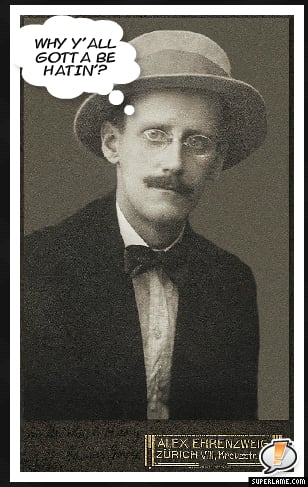Ah, the infamous James Joyce, bane of millions of high school and college students, and now it’s your turn to face the coming-of-age trial: writing a literary analysis of Araby by James Joyce.
You might be thinking “I didn’t sign up for this.” You might not be an English major or really interested in literature at all, but you still have to carry this burden on your shoulders (and the same week of your big math test, too!).
If you want to knock this assignment out of the water and show James Joyce who’s boss, this post gives you the tips to make that happen.
Tip #1: Make Sure You Understand Araby by James Joyce
Before you can start thinking about putting your essay to paper, you need to know what the story is actually about. First of all, you need to read the story for yourself; don’t rely on summaries to help you understand. You can, however, use the summaries and websites such as SparkNotes to get a deeper understanding of the story once you have read it.
While you’re reading, make notes of elements in Araby that seem strange or interesting.
For instance, you might realize that Mangan’s sister always wears brown. Why does Joyce emphasize that? Asking questions like that will help you develop your essay topic later.
Tip #2: Learn How to Write a Literary Analysis (An Overview)
Before you can dig into your essay on Araby by James Joyce, you need to have a really good idea of what a literary analysis entails. After all, you don’t want to jump blindly into the writing. You might end up in a jumbled heap that even the great James Joyce couldn’t sort out.
The first step to writing a great literary analysis is to pick a topic specific enough for you to successfully cover in your essay. If your essay only needs to be two pages, you don’t want to try to tackle the significance of all the religious symbolism within Araby. Instead, you could talk about the role of the priest in the short story.
Once you have your ultra-super-specific topic, you need to choose examples from the text to support your argument. Whenever we talked about including evidence in an essay, my favorite English professor always drilled the quote sandwich method into our heads.
First, as the top slice of bread, start with the claim you want to make in paragraph (also called a topic sentence). Then, you need a piece of evidence (paraphrase or quote from the text) as your meaty meat and saucy sauce. To finish it off with a nice thick piece of bread, you need analysis, which is your description of why the quote proves your claim and connects back to your thesis statement.
Repeat after me: topic sentence, quote, analysis. Topic sentence, quote, analysis. Topic sentence, quote, analysis. Voila! A delicious quote sandwich.
If you are still a bit hazy on how to write a literary analysis, check out this article!
But, wait, we’re getting ahead of ourselves. I need to walk you through coming up with a great topic for your analysis of Araby by James Joyce.
Tip #3: Choose a Good Theme for Your Literary Analysis of Araby by James Joyce
Now that you know how to write a literary analysis in a sandwich—I mean a nutshell—it’s time to start narrowing down your topic. This hurdle is the biggest one to get over, but it’s all downhill once you’re there, I promise.
There are several main themes in Araby that you can choose from. Make sure you choose one that interests you so you can really dig deeply into what makes the theme so apparent in the short story.
Here are some examples of the themes in Araby by James Joyce to get your brain running:
- Loss of innocence
- Coming of age
- Romantic infatuation vs. religious enthusiasm
- The death of the medieval romance
- Obsession with exotic cultures
For more ideas of which themes are present in Araby, see this resource!
Once you have a theme in mind, the next step is to to look into the specifics of why and how that theme exists in the story. What literary devices does Joyce use to give the reader those ideas? Which characters serve to further those concepts?
Tip #4: Focus on One Literary Element that Appears in Araby
For most literary analyses, you will only have space for analysis of one literary element. One literary element can often fill up several pages, and most literary papers are not much longer than that.
With that in mind, don’t worry about trying to cover everything about the story in your essay. Your instructor does not expect that. What he or she does expect is getting down and dirty with your specifics.
Give me as much detail in your essay as there is in this mosaic from the floor of Dublin’s city hall! Or, maybe not that much.
With Araby by James Joyce, there are plenty of literary elements to choose from, so make sure you choose the one that supports the theme you chose the best. Here are some examples of literary elements you can find in this short story:
- Characterization
- Imagery (specifically the setting)
- Point of view (first-person narration)
- Diction
- Symbolism
Though there are many other literary elements at play in Araby, the ones listed above are some of the most obvious, which also makes it simpler to find evidence of them within the text.
Tip #5: Write an Effective Thesis Statement
Your thesis statement will give you an outline for where your paper needs to go. Now that you have chosen your theme and the literary element you want to focus on, you can build your thesis statement for your literary analysis of Araby by James Joyce in no time at all! Don’t believe me? Let me give you a formula for what your thesis statement might look like:
In “Araby,” James Joyce uses (insert literary element here) to demonstrate that (insert theme here).
Now that you have the basis of your thesis statement, you need to make it more specific.
Make sure you qualify the literary element that you are using. For instance, if you want to use the setting, you might say the following:
In “Araby,” James Joyce uses dark colors and uniform houses in the setting to convey the inevitable somberness that characterizes growing up.
When you add details to what type of setting or imagery Joyce uses, you really beef up your thesis statement.
Tip #6: Finding Textual Examples to Support Your Argument about Setting in Araby
Before we dig into some examples, here’s a picture of Dublin in 1900 to set the mood.
With Joyce, you can almost always count on heavy descriptions of the setting, which we can use as juicy textual examples to support the sample thesis statement from earlier. Here are some great textual examples for talking about setting in “Araby” by James Joyce:
- “The other houses of the street, conscious of decent lives within them, gazed at one another with brown imperturbable faces” (Joyce)
- “The wild garden behind the house contained a central apple-tree and a few straggling bushes” (Joyce)
- “An uninhabited house of two storeys stood at the blind end, detached from its neighbours in a square ground” (Joyce)
- “The high, cold, empty, gloomy rooms liberated me” (Joyce)
Let’s use one of these examples to create a sample paragraph that you might see in a literary analysis of this short story.
Remember, when you’re writing your literary analysis, use the quote sandwich method. I’ve color coded each part of your sandwich (topic, quote, analysis.)
The language Joyce employs to describe the setting exemplifies the ugliness that is adulthood. For instance, the narrator talks about the “high, cold, empty, gloomy rooms” of his uncle’s house, which, though they serve to lessen the narrator’s nerves, still make the house unwelcoming (Joyce). Since owning and keeping up a home is an adult responsibility, Joyce paints adulthood as a somber state of being.
Here, I embedded the quote into a sentence and sandwiched that sentence between my topic sentence and my analysis, which connects it back to my original thesis statement.
If you were to finish out this essay, you would want to write several more paragraphs like this and connect them altogether into a very well-developed and convincing argument about why Joyce wrote Araby the way he did.
Tip #7: How to Talk about Symbolism in Araby
If you’re not too keen about writing about the setting in Araby by James Joyce, that’s okay!
When you’re working with a symbol, you need to choose one symbol and use that as your literary element. You should typically only focus on one symbol in a short essay (2-3 pages).
Here are some symbols from Araby you could write about:
- Mangan’s sister as a symbol for medieval romance
- The jars at the bazaar as a symbol of Eastern/foreign cultures and colonization
- Money as a symbol of the restrictiveness of adulthood
Once you have chosen the symbol you want to work with, make sure you find the textual examples that describe that symbol best. You can follow the steps I laid out in tips 5 and 6 to develop a thesis statement and supporting paragraphs around the symbol you choose.
Interested in writing about religious symbols? Check out this Take a look at these essays.
Tip #8: Edit Your Literary Analysis about Araby
To make sure to re-read, revise, and edit your essay before your instructor inspects it, or hand it over to the Kibin editors! We can help you iron out your details and get all your MLA citations right to create an essay that is sure to get you a better grade.
Speaking of MLA citations, here is mine:
Works Cited:
Joyce, James. “Araby.” Fiction: The Eserver Collection. Web. 29 Apr. 2015.
In Summary
It turns out writing a literary analysis of Araby by James Joyce isn’t so hard after all! Remember to do the following:
- Pick a good theme.
- Select one literary element that supports the theme.
- Write a thesis statement that describes how the literary element supports the theme.
- For each body paragraph, choose evidence from the text and sandwich direct quotes with your commentary (topic, quote, analysis).
- For help on putting your paper together, read This Analytical Essay Outline Will Kickstart Your Writing
Follow these guidelines, and you will have a literary analysis essay that is worthy of Joyce.
Good luck!



